Arminius
| Arminius | |
|---|---|
| Chieftain of the Cherusci | |
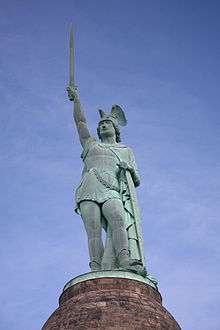 Hermannsdenkmal memorial | |
| Born |
18/17 BC Germania |
| Died |
AD 19 Germania |
| Spouse | Thusnelda |
| Issue | Thumelicus |
| Father | Segimerus |
Arminius (German: Hermann; 18/17 BC – AD 19) was a chieftain of the Germanic Cherusci tribe and a former officer in the Roman military. An auxiliary lieutenant to the Roman general Publius Quinctilius Varus, Arminius used his knowledge of Roman tactics to lead an allied coalition of Germanic tribes to a decisive victory against three Roman legions and their auxiliaries in the historic Battle of the Teutoburg Forest, in 9 AD.
The defeat would precipitate the Roman Empire's permanent strategic withdrawal from Magna Germania, and the Romans were to make no more concerted attempts to conquer and hold Germania beyond the Rhine river. Modern historians have regarded Arminius's victory as "Rome's greatest defeat"[1] and one of the most decisive battles in history.[2][3][4][5][6] After subsequent defeats by the Roman general Germanicus, nephew of the Emperor Tiberius, Arminius′ influence waned and he was assassinated on the orders of rival Germanic chiefs.[7]
During the Unification of Germany in the 19th century, Arminius became hailed by nationalists as a symbol of German unity and freedom.[8] Following World War II, however, schools often shunned the topic since it had become associated with the militant nationialism of the Third Reich, and many modern Germans have not heard about Arminius.[8] The 2000th year anniversary of the battle was not commemorated by the German government.[8]
Name
The origin of the Latin name of Arminius is unknown.
The origin of the name "Hermann" dates from the 16th century, possibly first by Luther,[9] the name Arminius was identified as a Latinized form of the name Hermann. As a consequence, Arminius is traditionally known as Hermann der Cheruskerfürst in German. Hermann is also the German for "Man of War". Coming from the Old High German "heri"-war, and "man", man. [10] [11]
Biography
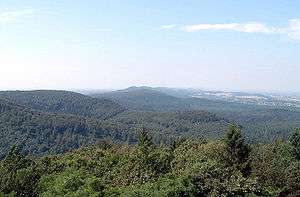
Arminius, born in 18 or 17 B.C., was son of the Cheruscan chief Segimerus (German: Segimer) and trained as a Roman military commander alongside his younger brother Flavus. He had lived in Rome as a hostage in his youth, where he had received a military education and obtained Roman citizenship as well as the status of equestrian (petty noble) before returning to Germania and driving the Romans out.[12]
Battle of the Teutoburg Forest

Around the year A.D. 4, Arminius assumed command of a Cheruscan detachment of Roman auxiliary forces, probably while fighting in the Pannonian wars on the Balkan peninsula. He returned to northern Germania in A.D. 7 or 8, where the Roman Empire had established secure control of the territories just east of the Rhine, along the Lippe and Main rivers, and was now seeking to extend its hegemony eastward to the Weser and Elbe rivers, under Publius Quinctilius Varus, a high-ranking administrative official appointed by Augustus as governor. Arminius began plotting to unite various Germanic tribes to thwart Roman efforts to incorporate their lands into the empire.
In the autumn of A.D. 9, the 25-year-old Arminius brought to Varus a report of rebellion in northern Germany. He persuaded Varus to divert the three legions under his command (composed of the 17th, 18th and 19th legions, plus three cavalry detachments and six cohorts of auxiliaries) from the march to winter quarters to suppress the rebellion. Varus and his legions marched right into the trap Arminius had set for them near Kalkriese, the Battle of the Teutoburg Forest. Arminius's tribe, the Cherusci, and their allies the Marsi, Chatti, Bructeri, Chauci, and Sicambri (five out of at least fifty Germanic tribes at the time)[8] ambushed and annihilated Varus's entire army, totaling over 20,000 men. Recent archaeological finds show the long-debated location of the three-day battle was almost certainly near Kalkriese Hill, about 20 km north of Osnabrück. When defeat was certain, Varus committed suicide by falling on his sword. Arminius's success in destroying three entire legions and driving the Romans out of Germany was one of the most devastating defeats Rome suffered in its history, and a high point of Germanic power for centuries. Roman attempts to reconquer Germany failed although they managed to break Arminius's alliance.
Roman retaliation, inter-tribal conflicts, and death

Between 14 and 16 AD, Germanicus launched punitive operations into Germany, twice defeating Arminius (according to Tacitus): first in the Battle of the Weser River and later near the Wall of the Angrivarii. Arminius also faced opposition from his father-in-law and other pro-Roman Germanic leaders.[13] In AD 15 Roman troops managed to recapture one of the three legionary eagles lost in the Battle of the Teutoburg Forest. In AD 16, a second eagle was retrieved.[14] Tiberius denied the request of Germanicus to launch an additional campaign for AD 17, however, having decided the frontier with Germania would stand at the Rhine river. Instead, he offered Germanicus the honor of a triumph for his two victories. The third Roman eagle was recovered in AD 41 by Publius Gabinius, under the emperor Claudius.[15]
With the end of the Roman threat, a war broke out between Arminius and Marbod, king of the Marcomanni. It ended with Marbod fleeing to Ravenna and Roman protection, but Arminius failed to break into the "natural fortification" of Bohemia, and the war ended in stalemate.
In 19 AD, Germanicus died in Antioch under circumstances which led many to believe he had been poisoned by his opponents. Arminius suffered death two years later, in 21 AD, murdered by opponents within his own tribe who felt that he was becoming too powerful.[16] Tiberius allegedly had refused an earlier offer from a Chatti nobleman to poison Arminius: "It was not by secret treachery but openly and by arms that the people of Rome avenged themselves on their enemies."[17]
Roman attempts to reconquer Germany failed although the Romans inflicted several defeats on the Germans.

Arminius's victory against the Roman legions in the Teutoburg Forest had a far-reaching effect on the subsequent history of both the ancient Germanic peoples and on the Roman Empire. The Romans were to make no more concerted attempts to conquer and permanently hold Germania beyond the river Rhine and the Agri Decumates. Modern historians have regarded Arminius's victory as "Rome's greatest defeat"[1] and one of the most decisive battles in history.[2][3][4][5][6][12] During the Unification of Germany in the 19th century, Arminius became hailed as a symbol of German unity and freedom.[8]
Legacy
Arminius had married a princess named Thusnelda, whose name is preserved only by Strabo. She was captured by the Romans while pregnant, so her son Thumelicus, grew up in Roman captivity. Tacitus tells us he had an unusual story, which the historian promises to tell, but it has been lost to us.
Rome
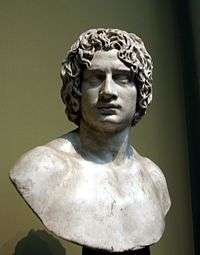
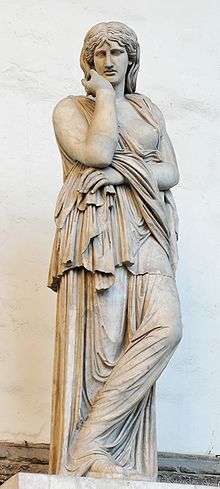
In the accounts of his Roman enemies, Arminius is highly regarded for his military leadership skills and as a defender of the liberty of his people. Based on these records, the story of Arminius was revived in the sixteenth century with the recovery of the histories of Tacitus, who wrote in his Annales II, 88:
Arminius, without doubt Germania's liberator, who challenged the Roman people not in its beginnings like other kings and leaders, but in the peak of its empire; in battles with changing success, undefeated in the war.
Arminius was not the only reason for Rome's change of policy towards Germania. Politics also played a factor; emperors could rarely trust a large army to a potential rival, though Augustus had enough family members to wage his wars. Also, Augustus, in his 30-year reign, had annexed many territories still at the beginning of the process of Romanization.
Tiberius, successor of Augustus, decided that Germania was a far less developed land, possessing few villages, with only a small food surplus, and therefore was not currently important to Rome. It would require a commitment too burdensome for the imperial finances and for excessive expenditure of military force for a new achievement.
Modern scholars have pointed out that the Rhine was a more practical boundary for the Roman Empire than any other river in Germania. Armies on the Rhine could be supplied from the Mediterranean sea via the Rhône, Saône and Mosel, with a brief area of portage. Armies on the Elbe, however, would have to have been supplied by extensive overland routes or by ships travelling the hazardous Atlantic. Economically, the Rhine already had towns and sizable villages at the time of the Gallic conquest. The Rhine was significantly more accessible from Rome and better equipped to supply sizeable garrisons than the regions beyond.[19]
Rome would control Germania by appointing client kings, which was cheaper than military campaigns.
Rome chose no longer to rule directly in Germania east of the Rhine and north of the Danube; Rome preferred to exert indirect influence through client kings, so Italicus, nephew of Arminius, was appointed king of the Cherusci; Vangio and Sido became vassal princes of the powerful Suebi, etc.[20]
If indirect methods proved insufficient to control the Germanic tribes beyond the Rhine, Roman Emperors would lead devastating punitive campaigns deep into Germania. One of them, led by the Roman emperor Maximinus Thrax, resulted in a Roman victory in 235 CE at the Battle at the Harzhorn Hill,[21] which is located in the modern German state of Lower Saxony, east of the Weser river, between the towns of Kalefeld and Bad Gandersheim.
Old Norse sagas
In the early 19th century, attempts were made to show that the story of Arminius and his victory may have lived on in the Old Norse sagas,[22] in the form of the dragon slayer Sigurd of the Völsunga saga and the Nibelungenlied. An Icelandic account[23][24] states that Sigurd "slew the dragon" in the Gnitaheidr—today the suburb Knetterheide of the city of Bad Salzuflen, located at a strategic site on the Werre river which could very well have been the point of departure of Varus's legions on their way to their doom in the Teutoburg Forest. Also one of the foremost Scandinavian scholars of the 19th century, Guðbrandur Vigfússon,[25] identifies Sigurd as Arminius. This educated guess was also picked up by Otto Höfler, who was a prominent National Socialist academic in World War II.[26]
German nationalism
In Germany, the name Arminius was interpreted as reflecting the name Hermann by Martin Luther, who saw Arminius as a symbol of the German people and their fight against Rome.[27]
Hermann der Cheruskerfürst became an emblem of the revival of German nationalism fueled by the Napoleonic Wars in the 19th century.[28]
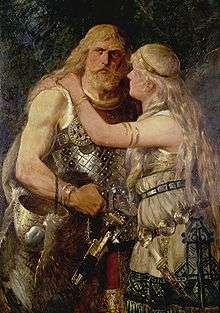
In 1808, Heinrich von Kleist wrote the play Die Hermannsschlacht [29] but with Napoleon's victory at Wagram it remained in manuscript, being published in 1821 and not staged until 1860. The play has been revived repeatedly at moments propitious for raw expressions of National Romanticism and was especially popular during the Third Reich.[30]
In 1839, construction was started on a massive statue of Arminius, known as the Hermannsdenkmal, on a hill near Detmold in the Teutoburg Forest; it was finally completed and dedicated during the early years of the Second German Empire in the wake of the German victory over France in the Franco-Prussian War of 1870– 1871. The monument has been a major tourist attraction ever since, as has The Hermann Heights Monument, a similar statue erected in New Ulm, Minnesota in the United States in 1897.
The Hermann Heights monument was erected by the Sons of Hermann, a fraternal organization formed by German Americans in New York City in 1840 and named for Hermann the Cheruscan that during the nineteenth century flourished in American cities with large populations of German origin. Hermann, Missouri, a town on the Missouri River founded in the 1830s and incorporated in 1845, was also named for Arminius.
The German Bundesliga football-club DSC Arminia Bielefeld is named after Arminius.
Following World War II, information about Arminius and his victory was omitted from the German textbooks, and most modern Germans don't know about Arminius.[8] The 2,000 year anniversary of the battle was not commemorated by the German government.[8] According to Der Spiegel: "The old nationalism has been replaced by an easy-going patriotism that mainly manifests itself at sporting events like the soccer World Cup."[8]
Site of the battle
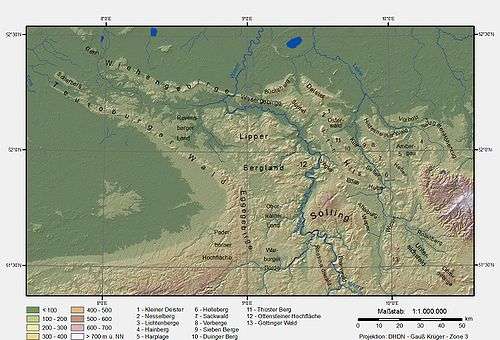



For almost 2,000 years, the site of the battle was unidentified. After World War II, it was taught that the story was only a legend with no real historical value. Despite the Roman historical accounts. Until a discovery by a novice treasure hunter proved the story of Hermann to be real.
The main clue to its location was an allusion to the saltus Teutoburgiensis in section i.60–62 of Tacitus' Annals, an area "not far" from the land between the upper reaches of the Lippe and Ems Rivers in central Westphalia. During the 19th century, theories as to the site abounded, and the followers of one theory successfully argued for a long wooded ridge called the Osning, near Bielefeld. This was then renamed the Teutoburg Forest.[32]
Late 20th-century research and excavations were sparked by finds by a British amateur archaeologist Major Tony Clunn, who was casually prospecting at Kalkriese Hill (52°26′29″N 8°08′26″E / 52.44139°N 8.14056°E) with a metal detector in the hope of finding "the odd Roman coin". He discovered coins from the reign of Augustus (and none later), and some ovoid leaden Roman sling bolts. Kalkriese is a village administratively part of the city of Bramsche, on the north slope fringes of the Wiehen, a ridge-like range of hills in Lower Saxony north of Osnabrück. This site, some 100 km north west of Osning, was first suggested by the 19th-century historian Theodor Mommsen, renowned for his fundamental work on Roman history.
Initial systematic excavations were carried out by the archaeological team of the Kulturhistorisches Museum Osnabrück under the direction of Professor Wolfgang Schlüter from 1987. Once the dimensions of the project had become apparent, a foundation was created to organise future excavations and to build and operate a museum on the site, and to centralise publicity and documentation. Since 1990 the excavations have been directed by Susanne Wilbers-Rost.
Excavations have revealed battle debris along a corridor almost 24 km (15 miles) from east to west and little more than a mile wide. A long zig-zagging wall of peat turves and packed sand had apparently been constructed beforehand: concentrations of battle debris in front of it and a dearth behind it testify to the Romans' inability to breach the Germans' strong defense. Human remains appear to corroborate Tacitus' account of the Roman legionaries' later burial.[33] Coins minted with the countermark VAR, distributed by Varus, also support the identification of the site. As a result, Kalkriese is now perceived to be the site of part of the battle, probably its conclusive phase.
The Varusschlacht Museum and Park Kalkriese includes a large outdoor area with trails leading to a re-creation of part of the earthen wall from the battle and other outdoor exhibits. An observation tower, which holds most of the indoor exhibits, allows visitors to get an overview of the battle site. A second building includes the ticket center, museum store and a restaurant. The museum houses a large number of artifacts found at the site, including fragments of studded sandals legionaries lost, spearheads, and a Roman officer's ceremonial face-mask, which was originally silver-plated.
Alternative theories on the battle's location
Although the majority of evidence has the battle taking place east and north of Osnabrück and the end at Kalkriese Hill, some scholars and others still adhere to older theories. Moreover, there is controversy among Kalkriese adherents themselves as to the details.
The German historians Peter Kehne and Reinhard Wolters believe that the battle was probably in the Detmold area, and that Kalkriese is the site of one of the battles in 15 CE. This theory is, however, in contradiction to Tacitus' account.
A number of authors, including the archaeologists Susanne Wilbers-Rost and Günther Moosbauer, historian Ralf Jahn, and British author Adrian Murdoch (see below), believe that the Roman army approached Kalkriese from roughly due east, from Minden, North Rhine-Westphalia, not from south of the Wiehen Hills (i.e., from Detmold). This would have involved a march along the northern edge of the Wiehen Hills, and the army would have passed through flat, open country, devoid of the dense forests and ravines described by Cassius Dio. Historians such as Gustav-Adolf Lehmann and Boris Dreyer counter that Cassius Dio's description is too detailed and differentiated to be thus dismissed.
Tony Clunn (see below), the discoverer of the battlefield, and a "southern-approach" proponent, believes that the battered Roman army regrouped north of Ostercappeln, where Varus committed suicide, and that the remnants were finally overcome at the Kalkriese Gap.
Peter Oppitz argues for a site in Paderborn, some 120 km south of Kalkriese. Based on a reinterpretation of the writings of Tacitus, Paterculus, and Florus and a new analysis of those of Cassius Dio, he proposes that an ambush took place in Varus's summer camp during a peaceful meeting between the Roman commanders and the Germans.[34]
Cultural references
- Music
- Arminio is a 1692 opera about Arminius by the Bohemian-Austrian composer Heinrich Ignaz Franz Biber.
- Arminio is a 1736 opera about Arminius by Handel.
- Arminius is an 1877 oratorio about Arminius by the German composer Max Bruch.
- Historical novels
- Robert Graves' fictional autobiography, I, Claudius includes a description of Arminius's campaigns, where he is called "Hermann"; he is killed by members of his own family when he tries to "issue orders like a king".
- In the Czech novel Zlomený Meč (Broken sword) by Eduard Štorch published in 1932 Arminius challenges the Marcomanni king Marobodus for the leadership of the Germanic tribes. The novel mistakenly shows the Celtic tribesmen as being Slavs to support the rising Slavonic identification of the nationalistic Czechs.
- Harry Turtledove's 2009 historical novel Give Me Back My Legions! is a fictional retelling of Arminius' story, from the points of view of Arminius himself, various Germans, and Varus and the Romans.
- At the end of G. A. Henty's 1887 historical novel about Hannibal and the Second Punic War, "The Young Carthaginian," the main fictional character, Malchus, a cousin of Hannibal, decides to settle with the tribes north of the Alps and becomes an ancestor of Arminius.
- Other literature
- In Jules Verne's 1879 novel "The Begum's Fortune", written with a strongly anti-German bias, one of brutish bodyguards employed by the book's German villain is called "Arminius".
- In Lion Feuchtwanger's novel "Die Geschwister Oppermann" ("The Oppermanns", 1933) a Jewish student at a high school in early Nazi Germany is driven to suicide by a Nazi-oriented teacher for a statement in his essay that the rebellion of Arminius never had a long-term effect on the rise of the German nation, because Arminius was betrayed to Romans by other German tribal chieftains soon after the battle in the Teutoburg Forest. The student is ordered to make a public apology, but prefers to kill himself.
- In 1945 by Newt Gingrich and William R. Forstchen, an alternate history novel describing a world in which Nazi Germany did not declare war on the United States in December, 1941, Operation Arminius is the code name for the German plan for the invasion of the United States.
- Film
- In the 2016 American docudrama Barbarians Rising, Arminius was played by Tom Hopper.
- Modern popular culture
- The Irish Black metal band Primordial recently referred to Arminius in a song off their To The Nameless Dead album named "Heathen Tribes" with the line "Arminius stood tall in Teutoborg" in relation to the Battle of the Teutoburg Forest.
- The German heavy metal band Rebellion has released a conceptual album about Arminius called Arminius - Furor Teutonicus.
- The Battle of the Teutoburg Forest is the subject of the song "Teutoburg (Ambush of Varus)", included in the album Caligvla by the Canadian death metal band Ex Deo.
- Arminius appeared in the historical battle (Battle of Teutoburg Forest) in the video game Total War: Rome 2.
- Arminius is a playable commander in the video game Total War: Arena.
See also
- Alaric I
- Ariovistus
- Athanaric
- Autaritus
- Boudica
- Boiorix
- Divico
- Flavus, brother of Arminius
- Fritigern
- Gaius Julius Civilis
- Inguiomer
- John of Gothia
- Mithradates the Great
- Teutobod
- Totila
- Gainas
- Tribigild
- Genseric
- Chrocus
- Radagaisus
- Odoacer
- Battle of Baduhenna Wood
- Brennus
- Boduognatus
- Belgios
- Brennus
- Ardaric
- Valamir
- Vercingetorix
- Viriathus
References
- 1 2 Murdoch 2012
- 1 2 Tucker 2010, p. 75
- 1 2 Cawthorne 2012
- 1 2 Davis 1999, p. 68
- 1 2 Creasy 2007, p. 104
- 1 2 "How the eagles were tamed". The Spectator. March 27, 2004. Retrieved January 16, 2015.
Mommsen referred to the Battle of the Teutoburg forest as a turning-point in world history.
- ↑ Tacitus, Annals 2.22 ff.; Suetonius, Caligula 1.4; Dio 57.18.1; on Arminius' assassination, Tac. Ann. 2.88;
- 1 2 3 4 5 6 7 8 Crossland, David (August 28, 2009). "Battle of the Teutoburg Forest: Germany Recalls Myth That Created the Nation". Spiegel Online International. Der Spiegel. Retrieved January 16, 2015.
- ↑ Herbert W. Benario (April 2004). "Arminius into Hermann: History into Legend". Greece and Rome. 51 (1): 83–94. doi:10.1093/gr/51.1.83.
- ↑ Förstemann, Ernst Wilhelm (1900). Altdeutsches Namenbuch (in German). Nabu Press. ISBN 9781270714996.
- ↑ http://www.vorname.com/name,Hermann.html
- 1 2 Durschmied 2013, p. p. 1759
- ↑ Tac. Ann. 1.54-59.
- ↑ Tac. Ann. 1.60.4, 2.25.2
- ↑ Dio 60.8.7.
- ↑ Tacitus, The Annals 2.88
- ↑ Tac. Ann. 2.87-88.
- ↑ "Arminius". Encyclopædia Britannica.
- ↑ Peter Heather, (2006), The Fall of the Roman Empire: A New History of Rome and the Barbarians
- ↑ Tacitus, Book 12 [verse 27 to 31]
- ↑ Historia Augusta, The Two Maximini 12:1-4; Herodian, Roman History, Book 7:2:3
- ↑ A. Giesebrecht (1837). "Ueber den Ursprung der Siegfriedsage". Germania (2).
- ↑ unknown (1387). "Nikulas Bergsson, Arnamagnæan Collection manuscript 194, 8yo".
- ↑ Simek, R. (1990). "Altnordische Kosmographie: Studien und Quellen zu Weltbild und Weltbeschreibung in Norwegen und in Island vom 12. bis zum 14. Jahrhundert". Berlin/New York.
- ↑ G. Vigfusson, F. York Powell (1886). "Grimm centenary; Sigfred-Arminivs, and other papers". Oxford Clarendon Press.
- ↑ O. Höfler, "Siegfried Arminius und die Symbolik," Heidelberg (1961), 60–64,and also in Siegfried, Arminius und der Nibelungenhort (Vienna 1978);F.G. Gentry, W. McConnell, W. Wunderlich (eds.), The Nibelungen Tradition. An Encyclopedia (New York–London 2002), article "Sigurd".
- ↑ W. Bradford Smith (2004). "German Pagan Antiquity in Lutheran Historical Thought". The Journal of the Historical Society. 4 (3): 351–74. doi:10.1111/j.1529-921X.2004.00104.x.
- ↑ Dorothea Klein (ed.), Lutz Käppel (ed.): Das diskursive Erbe Europas: Antike und Antikerezeption. Peter Lang, 2008, ISBN 9783631560136, p. 329
- ↑ Heinrich von Kleist: Die Herrmannsschlacht. Ein Drama [1808] (Frankfurt am Main and Basel: Stroemfeld-Roter Stern, 2001).
- ↑ Reeve, William C (2004). "Die Hermannsschlacht". The Literary Encyclopedia. The Literary Dictionary Company. Retrieved 2006-09-06.
- ↑ Wolfgang Schlüter: Zwischen Lutherdamm und Oberesch – Die Anfänge des Kalkriese-Projektes. In: Varus-Gesellschaft (Ed.): Varus-Kurier. Georgsmarienhütte, April 2002. pp. 7 ff. (German)
- ↑ Archaeologia Polona. Polska Akademia Nauk. 1998. p. 244. Retrieved 18 November 2012.
At the time, the location of the battle, the Cheruscan tribal seat, even Arminius' real name were unknown. The Teutoburg Forest, called the Osning Forest throughout the Middle Ages, was renamed after Tacitus' account
- ↑ Smithsonian, p 81; Tacitus, Annals 1.60.
- ↑ Das Geheimnis der Varusschlacht, Kelkheim, Germany: Zagara-Verlag, 2006 (German)
Sources
- Cawthorne, Nigel (July 24, 2012). Battles That Changed History: An Encyclopedia of World Conflict. Arcturus Publishing. pp. 75–77. ISBN 1848589549.
- Davis, Paul K. (1999). 100 Decisive Battles: From Ancient Times to the Present. Oxford University Press. pp. 68–71. ISBN 0195143663.
- Andreas Dörner, Politischer Mythos und symbolische Politik. Der Hermannmythos: Zur Entstehung des Nationalbewußtseins der Deutschen (Reinbek: Rowohlt, 1996).
- Durschmied, Erik (April 13, 2013). The Weather Factor: How Nature Has Changed History. Hachette UK. pp. 1751–1770. ISBN 1444769650.
- Gesa von Essen, Hermannsschlachten. Germanen- und Römerbilder in der Literatur des 18. und 19. Jahrhunderts (Göttingen: Wallstein, 1998).
- Richard Kuehnemund, Arminius or the Rise of a National Symbol in Literature. From Hutten to Grabbe (New York: AMS Press, 1966).
- Herfried Münkler / Hans Grünberger: Arminius/ Hermann als nationales Symbol im Diskurs der deutschen Humanisten 1500-1570, In: Herfried Münkler / Hans Grünberger / Kathrin Mayer, Nationenbildung. Die Nationalisierung Europas im Diskurs humanistischer Intellektueller. Italien und Deutschland (Berlin: Akademie, 1998), pp. 263–308.
- Murdoch, Adrian (1 December 2012). Rome's Greatest Defeat: Massacre in the Teutoburg Forest. The History Press. ISBN 0752494554.
- Tucker, Spencer (2010). Battles That Changed History: An Encyclopedia of World Conflict. ABC-CLIO. ISBN 1598844296.
- Martina Wagner-Egelhaaf (Ed.), Hermanns Schlachten. Zur Literaturgeschichte eines nationalen Mythos (Bielefeld: Aisthesis, 2008).
- Reinhard Wolters, Die Schlacht im Teutoburger Wald: Arminius, Varus und das roemische Germanien (München: Verlag C.H. Beck, 2008).
External links
| Wikimedia Commons has media related to Arminius. |
| Wikisource has the text of the 1911 Encyclopædia Britannica article Arminius. |
- Arminius / Varus. The Battle of the Teutoburg Forest - Internet-Portal „Westfälische Geschichte“, LWL-Institut für westfälische Regionalgeschichte, Münster
- Terry Jones' Barbarians – The Savage Goths (Google Video) – includes a portion on Arminius
- (German) A description of Arminius and his fight against the Romans
- "They Need a Hero" by Clay Risen, The National, October 9, 2009 – an article on modern German views of Hermann and the 2,000th anniversary of the battle